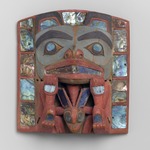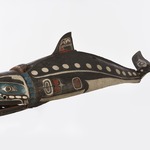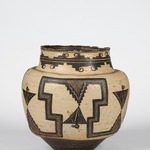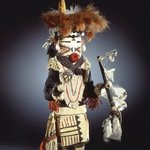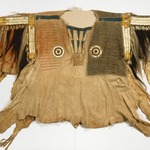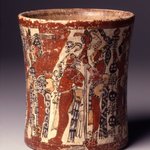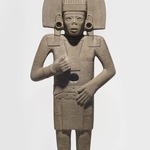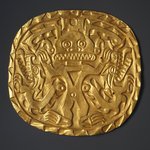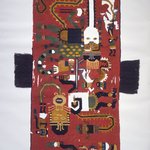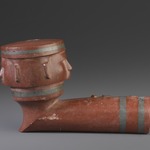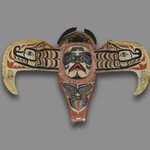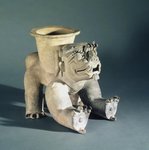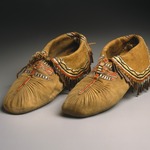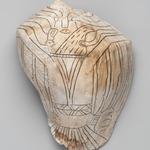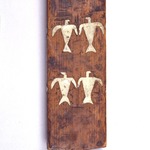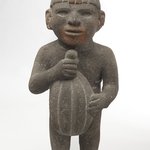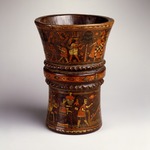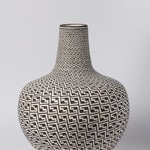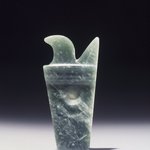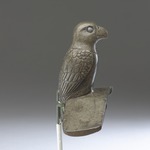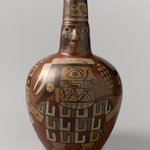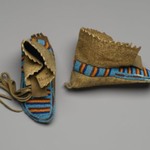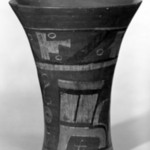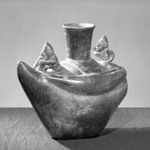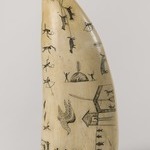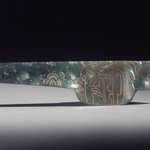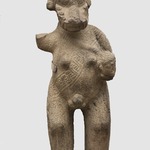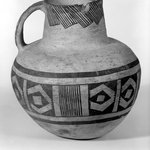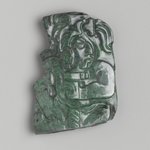Collection: Arts of the Americas
HIGHLIGHTS
FULL COLLECTION
COLLECTION HISTORY
The collection of the arts of the Americas began to be formed as early as 1903. The first two curators, Stewart Culin (served 1903–29) and Herbert Spinden (served 1929–50), provided the important foundation on which the collection has continued to be built.
Building the Collection
Stewart Culin, an adventurous and energetic ethnologist, initiated the acquisition of Native American artworks in the early twentieth century, long before other American art museums became interested in the indigenous arts of North, Central, and South America. Between 1903 and 1911, Culin acquired more than nine thousand objects for the collection through Museum-sponsored expeditions to the Southwest, Northwest Coast, California, and Oklahoma. Because of his efforts, the Museum's Native American collections are particularly strong in Northwest Coast material such as masks, hats, rattles, baskets, and carvings (both small and monumental) of the Nuu-chah-nulth, Heiltsuk, Kwakwaka'wakw, Tshimian, Haida, and Tlingit tribes; Southwest material such as polychrome ceramics, embroidered textiles, and elaborately costumed Kachina dolls made by Hopi and Zuni artisans; California material such as baskets, clothing, and feathered headdresses of the Pomo, Hupa, Yurok, and Maidu peoples; and Plains material such as the spectacular fur regalia and beadwork of the Osage of Oklahoma. Culin's comprehensive diaries and field notes provide unique information on the objects that he acquired and are available to researchers by appointment in the Museum's Libraries and Archives.
In 1929, Culin was succeeded by Herbert Spinden, an archaeologist already well known for his pioneering work on ancient Maya art. Spinden focused on building the pre-Columbian and ethnographic art collections from Mexico and Central and South America. During his twenty-one years at the Museum (he retired in 1950), Spinden conducted at least seven collecting expeditions to Mexico, Nicaragua, Panama, Colombia, Ecuador, Peru, Bolivia, Chile, and Argentina. He also acquired significant private collections such as a group of ancient Paracas textiles from Peru (the majority of which were acquired as a single purchase in 1934). The Museum's Paracas textile collection is one of the largest in the United States, and among the four most significant collections outside Peru. A famous ceremonial mantle made between 300 B.C.E. and 100 C.E., known as the Paracas Textile, is perhaps the most renowned of all the objects in the collection of the arts of the Americas. Spinden also acquired significant examples of ancient Mexican stonework, such as a Huastec life-death figure from northern Veracruz, which is one of the finest and most complete examples of its kind. The extensive Costa Rican archaeological collection consists of exquisite stone carvings and ceramics. Spinden also expanded the Native American holdings by acquiring a collection of 163 Plains objects assembled by Nathan Sturges Jarvis, who was a military surgeon in Fort Snelling, Minnesota, between 1833 and 1836. This rare, nineteenth-century collection includes several exceptional examples of early hide clothing embellished with beads and quillwork in both traditional and inventive motifs.
Spinden was also interested in the interaction between pre-Columbian and European-influenced cultures of the post-Conquest period, and this interest placed the Museum at the vanguard of collecting, studying, and exhibiting Spanish colonial art. Today our Spanish colonial collection is one of the largest and finest in the world. Notable for its breadth, high aesthetic quality, and historical importance, the collection includes paintings, sculpture, furniture, silver, domestic and ceremonial objects, textiles, costumes, and manuscripts. The majority of works come from Mexico, Peru, Bolivia, Chile, and Argentina, regions that were encompassed by the vice-royalties of New Spain and Peru during the colonial period.
The Collection Today
In addition to extensive Native American and Spanish colonial holdings, our collection of the arts of the Americas includes pre-Columbian Andean textiles, modern textiles that demonstrate the continuity of weaving traditions, stone sculptures, ceramics, jade carvings, gold and silver ornaments, and wood carvings. Mesoamerican holdings allow the Museum to present objects from all the major regional cultural traditions, such as Olmec, Maya, and Aztec. Similarly, Peru's artistic traditions from Chavin to Inca cultures are well represented. In addition to the well-known ancient arts of Peru and Mexico, the archaeological collection includes significant holdings from the Southwestern United States, Costa Rica, Ecuador, and Colombia. Thanks to astute acquisitions, we possess an unusually rich collection that encompasses the Western Hemisphere and stretches from 3000 B.C.E. to the present.
For over a century, the Brooklyn Museum has played an important role not just in acquiring indigenous arts of the Americas, but also in presenting and interpreting them. The Museum took the lead in redefining ethnographic and archaeological objects as artworks through special exhibitions, innovative displays, and educational programs. Through judicious, large-scale acquisitions (sometimes of collections numbering in the hundreds), field expeditions, donations, and purchases, the collection has grown in size to a current total of approximately thirty-five thousand objects. The scope and quality of the holdings make this among the foremost institutional collections in the country.
Curators today are now focusing their attention on the acquisition of contemporary works both in traditional and new media. Recent acquisitions include a glass sculpture of a killer whale by the Tlingit artist Preston Singletary, a ceramic sculpture by the Santa Clara artist Roxanne Swentzell, and a painting by the Navajo artist Emmi Whitehorse.
Building the Collection
Stewart Culin, an adventurous and energetic ethnologist, initiated the acquisition of Native American artworks in the early twentieth century, long before other American art museums became interested in the indigenous arts of North, Central, and South America. Between 1903 and 1911, Culin acquired more than nine thousand objects for the collection through Museum-sponsored expeditions to the Southwest, Northwest Coast, California, and Oklahoma. Because of his efforts, the Museum's Native American collections are particularly strong in Northwest Coast material such as masks, hats, rattles, baskets, and carvings (both small and monumental) of the Nuu-chah-nulth, Heiltsuk, Kwakwaka'wakw, Tshimian, Haida, and Tlingit tribes; Southwest material such as polychrome ceramics, embroidered textiles, and elaborately costumed Kachina dolls made by Hopi and Zuni artisans; California material such as baskets, clothing, and feathered headdresses of the Pomo, Hupa, Yurok, and Maidu peoples; and Plains material such as the spectacular fur regalia and beadwork of the Osage of Oklahoma. Culin's comprehensive diaries and field notes provide unique information on the objects that he acquired and are available to researchers by appointment in the Museum's Libraries and Archives.
In 1929, Culin was succeeded by Herbert Spinden, an archaeologist already well known for his pioneering work on ancient Maya art. Spinden focused on building the pre-Columbian and ethnographic art collections from Mexico and Central and South America. During his twenty-one years at the Museum (he retired in 1950), Spinden conducted at least seven collecting expeditions to Mexico, Nicaragua, Panama, Colombia, Ecuador, Peru, Bolivia, Chile, and Argentina. He also acquired significant private collections such as a group of ancient Paracas textiles from Peru (the majority of which were acquired as a single purchase in 1934). The Museum's Paracas textile collection is one of the largest in the United States, and among the four most significant collections outside Peru. A famous ceremonial mantle made between 300 B.C.E. and 100 C.E., known as the Paracas Textile, is perhaps the most renowned of all the objects in the collection of the arts of the Americas. Spinden also acquired significant examples of ancient Mexican stonework, such as a Huastec life-death figure from northern Veracruz, which is one of the finest and most complete examples of its kind. The extensive Costa Rican archaeological collection consists of exquisite stone carvings and ceramics. Spinden also expanded the Native American holdings by acquiring a collection of 163 Plains objects assembled by Nathan Sturges Jarvis, who was a military surgeon in Fort Snelling, Minnesota, between 1833 and 1836. This rare, nineteenth-century collection includes several exceptional examples of early hide clothing embellished with beads and quillwork in both traditional and inventive motifs.
Spinden was also interested in the interaction between pre-Columbian and European-influenced cultures of the post-Conquest period, and this interest placed the Museum at the vanguard of collecting, studying, and exhibiting Spanish colonial art. Today our Spanish colonial collection is one of the largest and finest in the world. Notable for its breadth, high aesthetic quality, and historical importance, the collection includes paintings, sculpture, furniture, silver, domestic and ceremonial objects, textiles, costumes, and manuscripts. The majority of works come from Mexico, Peru, Bolivia, Chile, and Argentina, regions that were encompassed by the vice-royalties of New Spain and Peru during the colonial period.
The Collection Today
In addition to extensive Native American and Spanish colonial holdings, our collection of the arts of the Americas includes pre-Columbian Andean textiles, modern textiles that demonstrate the continuity of weaving traditions, stone sculptures, ceramics, jade carvings, gold and silver ornaments, and wood carvings. Mesoamerican holdings allow the Museum to present objects from all the major regional cultural traditions, such as Olmec, Maya, and Aztec. Similarly, Peru's artistic traditions from Chavin to Inca cultures are well represented. In addition to the well-known ancient arts of Peru and Mexico, the archaeological collection includes significant holdings from the Southwestern United States, Costa Rica, Ecuador, and Colombia. Thanks to astute acquisitions, we possess an unusually rich collection that encompasses the Western Hemisphere and stretches from 3000 B.C.E. to the present.
For over a century, the Brooklyn Museum has played an important role not just in acquiring indigenous arts of the Americas, but also in presenting and interpreting them. The Museum took the lead in redefining ethnographic and archaeological objects as artworks through special exhibitions, innovative displays, and educational programs. Through judicious, large-scale acquisitions (sometimes of collections numbering in the hundreds), field expeditions, donations, and purchases, the collection has grown in size to a current total of approximately thirty-five thousand objects. The scope and quality of the holdings make this among the foremost institutional collections in the country.
Curators today are now focusing their attention on the acquisition of contemporary works both in traditional and new media. Recent acquisitions include a glass sculpture of a killer whale by the Tlingit artist Preston Singletary, a ceramic sculpture by the Santa Clara artist Roxanne Swentzell, and a painting by the Navajo artist Emmi Whitehorse.

